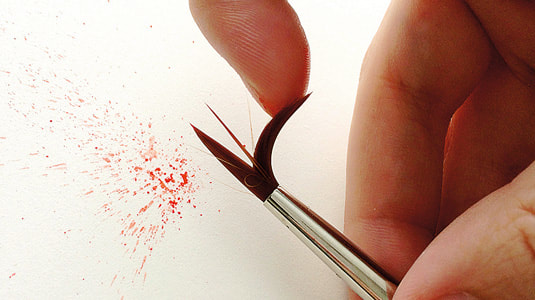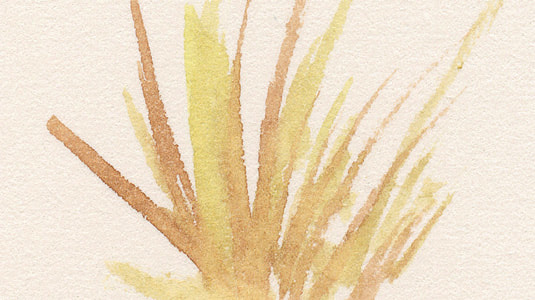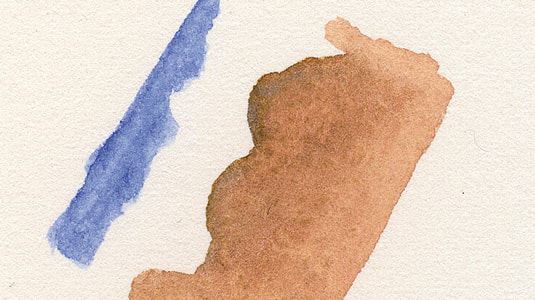Watercolor Techniques
1. Dry versus Wet
|
1. There are two major factors to consider when painting with watercolours: wet and dry. As the name suggests, watercolour is a water-based medium. We can manipulate the darkness and saturation of the pigment depending on how much water we add.
There are many ways to paint in watercolour and as you try them, you'll find the ones that work best for you. I've found working dry to wet helps me achieve more control. |
2. Work from light to dark.
|
Working from light to dark takes a lot of planning but the results are worth itAnother important watercolour technique to remember is that we're working from light to dark. This means that anything we're keeping white or light in our painting needs to stay that way for the whole duration of the work. We'll build our values up layer by layer to arrive at the effect we want. This does take a lot of planning but the results will be worth it.
|
3. Stock up on paper towles
|
The paper towel almost acts as a kneaded eraser for watercolour. One very important tool to have in your kit when working with watercolours is a paper towel. This almost acts as a kneaded eraser for your watercolours. Laying down a wash of colour and then lifting parts of it up is a great way to add layers of detail gradually. Paper towels are also very useful for correcting mistakes or redirecting the paint.
|
4. Splatter your watercolors
|
Using your index finger, pull back on the bristles and let them snap forward.
One handy trick to add some energy to your watercolour painting is to use a splatter watercolour technique. This can help suggest water spray or floating dust. Hold your paintbrush between your thumb and middle fingers. Using your index finger, pull back on the bristles and let them snap forward. This method is a bit unpredictable, but can yield some very fun results, so I’d urge you to give it a try. |
5. Blend colors
|
A good way to bleed colours into one another is through 'blooming'
A good way to bleed colours into one another is through the 'blooming' watercolour technique. Add a good amount of water to the pigment in your brush and apply it to the paper. When the stroke is still wet, add in another colour with the same amount of water. You can manipulate the colours to where they need to be at this point. Allow this to dry and you'll notice that there are subtle gradients throughout the stroke. Take a look at our guide to the wet-in-wet watercolour technique, too. |
6. Working with textures
|
It's important to try to depict objects and materials with their textures included
You'll notice that working in watercolours on a rougher paper does have its advantages. One of the obvious ones is that you don't have to work to hard to achieve a nice texture. That said, it's important to try to depict objects and materials with their textures included. This means using lights and darks as well as wets and drys. |
7. Pull in color
|
Pulling in colour is a great way to show form and indicate a light source or edgeWhen you apply a dry, more saturated stroke, you can pull from that stroke with just water. This watercolour technique is a great way to show form and indicate a light source or edge. Apply a stroke using very little water and more pigment. Before the stroke is dry, take a moderately wet brush and pull the colour out from the darker stroke. You can pull the colour quite far depending on how dry that initial stroke is.
|
8. Overlap or Glaze colors
|
Because watercolour is a thin medium, you'll need to build up colour gradually
Because watercolour is a thin medium, you'll need to build up colour gradually. This is another advantage to the medium as you can do some colour mixing right on the paper. Take one colour and lay it down. Allow it to dry and then revisit with another shade. You'll notice where they overlap, the pigment mixes and you're left with a different colour. This is great for building up flesh tones. |
9. Scumbling

Scumbling is a watercolour technique used create soft hues of layered pigment
Scumbling is a watercolour technique also used by many oil painters to create soft hues of layered pigment and light. You're essentially layering the colour in soft, indirect layers to create the hue and look you want. Simply lay in semi-wet strokes of paint in watercolour. As I apply more colour, I'm careful to keep adding water so the colours blend and stay soft. It can be easy to overwork and produce a muddy look, so less is more.
Scumbling is a watercolour technique also used by many oil painters to create soft hues of layered pigment and light. You're essentially layering the colour in soft, indirect layers to create the hue and look you want. Simply lay in semi-wet strokes of paint in watercolour. As I apply more colour, I'm careful to keep adding water so the colours blend and stay soft. It can be easy to overwork and produce a muddy look, so less is more.
10. Lift off the color
|
You can lift away colour to correct a mistake or adjust the lighting in a pieceSometimes you'll need to 'erase' your watercolour. While you can't return the paper to 100 per cent white, you can lift away colour to correct a mistake or adjust the lighting in a piece. Work with an already dry swatch of watercolour and using clear water, paint in the shape you'd like to lift out. Let it set for a just a minute then dab away the water with a paper towel. You'll see the colour lift out in the shape you painted in.
|
11. Create texture with salt
|
Salt can provide an interesting texture with little effort.
Watercolour is all about layering and texture. Salt can provide an interesting texture with little effort as the salt crystals absorb the water, leaving a unique pattern in the pigment. Lay down a swatch of watercolour and while the paint is still wet, sprinkle over salt. Let this sit until mostly dry and simply wipe or blow away the salt. This technique is useful for adding texture to natural surfaces like rocks or tree bark. |
12. Apply paint using a sponge
|
Another household item you can use to apply watercolours is a sponge
Another household item you can use to apply watercolours is a sponge. Simply mix your pigment in a small dish or tray, dip the sponge into the paint and blot onto your paper. You can alter the wetness of your paint and achieve different effects – a drier look would be suited for plant life or scaly skin, while a wet application might be more suited for waterscapes or clouds. |
13. Explore negative space
|
Think about where you'd like your whites and lights before you apply paint
Watercolour is about planning. Think about where you'd like your whites and lights before you apply paint. It's vital to keep control of your brush as you paint in the edge of where you'd like your negative space to begin. Load it with semi-wet pigment and paint along the edge of where you'd like your negative space to begin. Then pull the colour away from the edge of the stroke to fill in where you'd like pigment. |
14. Use tape for masking techniques
|
Use tape to mask of areas you'd like to keep clean and white
You can use tape to mask of areas you'd like to keep clean and white. This watercolour technique is useful for hard edges involving machinery or architecture. Just lay down the tape where you'd like the paper to stay white. Use a tape that won't rip your paper, such as drafting tape or painters' tape. Paint over and around the tape. Once your paint is dry, remove the tape slowly and you should have a straight, clean line. |












